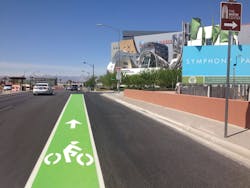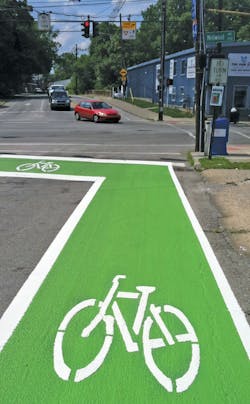Getting to the right green
Whether traveling through small towns like Wauwatosa, Wis., or tourist stops like Las Vegas, green lane treatments are increasingly being used to assist motorists in recognizing bicycle lanes.
An effort is underway to improve the quality of these pavement treatments. Once completed, agencies should have additional tools to ensure that materials provide improved color retention, durability and skid resistance.
The process, initiated by the material manufacturer members of the American Traffic Safety Services Association (ATSSA), working closely with American Association of State Highway & Transportation Officials (AASHTO) material engineers, will result in a first-ever green bicycle lane material specification. Upon completion, state and local agencies will be able to use this new specification in bid documents.
Approved for use by the Federal Highway Administration (FHWA) in 2011, the use of green pavement treatments has rapidly expanded beyond its original test locations in Portland, Ore. However, as cities began to install the treatments, it became apparent that not all materials performed well. Some material colors rapidly faded. Others simply were not durable and were quickly worn off pavements. Taxpayers complained and agencies were beginning to approach new potential installations with caution.
While significant work had been accomplished to develop guidance on where green lanes should be installed, product failures demonstrated that little effort had gone into material evaluation. Issues associated with color retention, skid resistance, durability and sustainability were examined. It was determined that the best way to approach the issue would be to utilize the current AASHTO system for evaluating roadway materials. AASHTO’s National Transportation Product Evaluation Program (NTPEP) has established practices, test decks and reporting mechanisms for evaluating new road materials. Road-marking materials have been part of this protocol for decades and a similar AASHTO/ATSSA effort had just recently developed a standardized specification and testing process for high-friction surface treatments, a material process used to improve safety on high-risk and curved locations.
Developing standards and tests for green-color lane treatments provides some unique challenges. First, weather is a major factor in determining wear and the impact of solar activity in degrading materials. The weather in snowbelt states and southern or coastal regions results in widely different evaluation criteria. Secondly, protected lanes also make skid resistance or friction testing more problematic. Friction field testing devices in the U.S. are typically designed to test runways or roads at higher speeds than those traditionally demarcated within towns and cities. Protected bicycle lanes provide additional complexity in limiting access to current testing devices. Finally, the significant variance in where materials are installed as well as the type of traffic and wear conditions impact demand issues associated with wear and tensile strength. Protected bicycle lanes, for example, operate primarily in locations where the only traffic on the system is bicycles and pedestrians. The lack of motor vehicle traffic likely limits the necessity of installing materials designed to resist the weights and wearing associated with vehicle traffic.
Green lane pavement treatments are being implemented across the nation to distinguish bicycle lanes for both motorist and cyclist safety.
The first issue addressed by the task group centered on the FHWA proposed color box. Material manufacturers agreed to send product samples for ultraviolet ray testing (ASTM G154) to a Jackson, Miss., based company, Future Labs LLC. This UV testing would create a baseline. Both 72- and 144-hour UV testing was applied to materials, the result of which demonstrated that materials faded and tended to drop towards the bottom of the color box after 72 hours and experienced only slight degradation between 72 and 144 hours of UV exposure. An examination of the color box also raised some concerns about color uniformity. The FHWA-proposed box would allow materials ranging from lime to yellow-mustard green. After consulting with the FHWA, a proposal to slightly adjust the color box was made, designed to create greater uniformity and to take into account the impacts of UV exposure.
The issue of material skid resistance offered a more difficult challenge. How do you develop a sustainable field testing method for evaluating bicycle lane material friction given the variety of locations where material would be installed? When bicycle lane systems were evaluated, it was realized that not only would it be important to develop a test for green lane materials, but that proposed specifications and test methods for symbols and markings that frame bicycle lanes were required. This road-markings issue added a new layer of complexity. Not only did we need a device that could measure friction on a relatively wide bicycle lane, but a device that would allow for testing of 6-in. lane markings as well. While a number of devices could be adapted for low-speed applications, these devices were pulled behind typical vehicles. What about protected bicycle lanes that are often behind curbs, flower pots or other barriers?
The task force began searching the European and Asian markets, hoping to find a device already in service. Fortunately, a company (Findlay Irvine) that had received a contract from the U.S. Department of Defense (DOD) to construct a device that could be used to evaluate friction for potential landing strips for C-17 cargo planes came to the fore. The idea was to have a device that could be strapped on the back of a paratrooper, dropped into a potential landing zone and quickly used to evaluate the possible landing site. While task force members had been searching abroad, this device was undergoing testing at Tyndall Air Force Base in Florida.
The DOD testing was designed to create a correlation between this new “micro-griptester” and devices currently in use by the Federal Aviation Administration for runways. Fortunately, these are the same devices transportation agencies have used for decades to evaluate roadway friction. The “micro-griptester” can be put in the trunk of a car and is operated manually. The narrow width of the test tire allows for the device to be used for bicycle lane materials, road markings and symbols. While the task force waits for final test results from the Tyndall friction test, work continues on developing the final friction table for inclusion within the final material specification.
While issues associated with color retention and friction measurement have been addressed, the last issue associated with differentiating between locations with primarily bicycle/pedestrian versus bicycle/pedestrian/vehicle traffic is yet to be finalized. The task force may decide to develop the initial specification based on a worst-case approach. This would ensure that the baseline specification would function under the greatest wear threat. It also would allow for variations to be developed and tested over time. Another possibility is to create a two-tiered system—bike/ped and bike/ped/vehicle. The problem with the second is that it would require the development of multiple test deck scenarios, thereby increasing the cost to manufacturers.
The goal at present is to have a final specification document approved by the summer of 2017 and a material testing process in place by 2018. In the interim, agencies interested in learning more about various material types presently at market can peruse state specifications for high-friction surfacing here.

